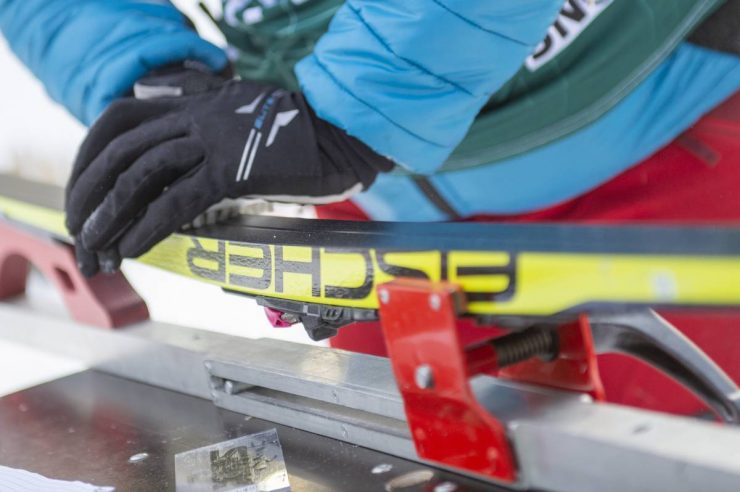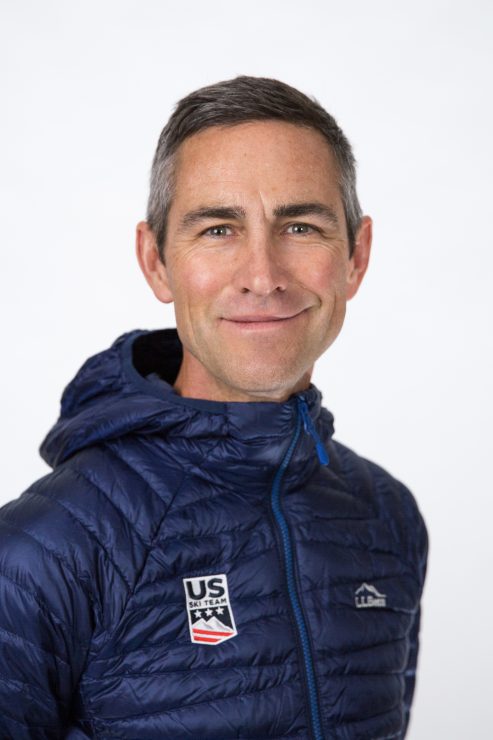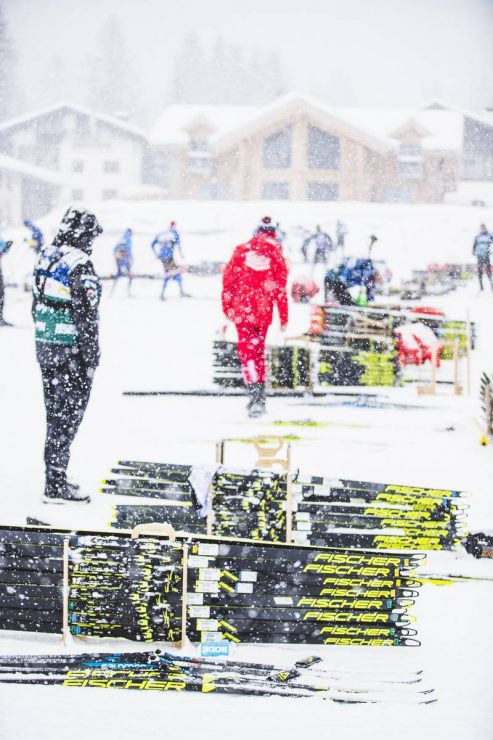
FasterSkier spoke with Chris Grover this week to discuss the International Ski Federation’s fluoro wax ban, which will be implemented this season, and the potential for a modified World Cup schedule. Grover is the Davis U.S. Cross Country Team Program Director and the former head coach of the U.S. team. He is also a member of the FIS Cross-Country Committee and the chair of the Sub-Committee for World and Continental Cups.
For starters, here is what FIS posted this week regarding the fluoro wax ban:
“The Council decided in November 2019 that the use of fluorinated ski wax will be banned for all FIS disciplines from the 2020-21 season which have been shown scientifically to have a negative environmental and health impact. Regulations have been established in USA that are already in place and will be implemented in the EU from July 2020 which impact the manufacturer of these products.
“Kompass has developed hand-held detector testing devices that will be certified by the Frauenhof Institute and tested during the summer months. Thereafter they will also be made available for the industry and teams. Subject to successful test of the prototype testing devices, the controls will be implemented from November 2020, with tests carried out in the start and finish areas.
“For the season 2020-21 the measurement limit will be defined to give the possibility for the manufacturers, service technicians and teams to adapt to the new situation. The measurement limit will be fixed based on the experience of the testing and validation phase in the summer 2020. From the 2021-22 season, after evaluation from the first season the measurement limit will be lowered to a possible minimum with the objective of a zero limit of fluorinated gliding compounds as from season 2022-23.”
To be clear up what you have read on the Internet, the fluoro ban will take effect this season. What has yet to be determined are the trace limits of fluoros that may be present on a ski base when tested prior to a FIS sanctioned race. In other words, if a “1” represents a full-blown fluoro powdered ski with topcoats, then FIS needs to determine if a hypothetical upper limit of say 0.1 or 0.05 is acceptable. Further, as FIS states, the upper limit for fluoros on a ski base will decrease even further for 2021-2022. The end goal is a limit of zero by 2022-2023.
(The real levels for a fluoro threshold have yet to be determined, the numbers used in the scenario above are hypothetical.)
***

Photo: U.S. Ski & Snowboard
FasterSkier: Although the FIS Council is banning fluoro wax for the upcoming season across all disciplines, it is, however, not set in stone. Does that sound accurate?
Chris Grover: You are right it is not set in stone. They are still developing this testing apparatus, and although it is apparently on schedule and they are going to be able to do some testing over the summer. They need to play around specifically with what the tolerances are for having environmental fluorocarbon on the ski base.
They have to figure out what is an acceptable tolerance and how much fluorocarbon could one potentially accumulate accidentally either in a contaminated wax room or wax truck or by skiing across the snow and picking up what somebody else left behind, or even from contaminated brushes or what have you.
So, that is really to be determined. And I think the statement that the FIS released after the council meeting yesterday to the general public said something like it is over two or three seasons they want to be able to reduce that tolerance. But I think that is the one thing they are trying to figure out.
From how it is going to impact the teams, what I understand from Pierre Mignerey [FIS Cross-Country Race Director], is that we are going ahead with a ban on the World Cup. There will be sporadic testing of athletes’ skis as they go to the start and also testing is possible at the finish of the race for anyone that stands out I suppose. Although they haven’t really discussed how they want to do that.
And then an athlete who is above the limit on fluorocarbon at the start will not be allowed to start and an athlete who is above the limit after finishing will be disqualified.
FS: Ok, so an athlete who flags a fluoro test above the limit will not be allowed to potentially swap out skis prior to racing?
CG: Correct. Which if you think about it, that makes sense. If you have an individual or a team that wanted to cheat, they could obviously run out there with skis that were above the limit, roll the dice that they would not be selected for testing and compete. And then if you have that opportunity to swap, then they can of course swap it before the start if they do get tested.
I think it is important, given that they will not be able to test nearly everybody in the field, that it basically is a “show up and if you are above the threshold you cannot start,” type of situation.
FS: Is the new testing device a more advanced piece of equipment that assays a swab that has been swiped across a ski base?
CG: I don’t know for sure. It is my understanding that this is a handheld device that can do a spot check and provide results at the time of the test. This is an immediate test. And so I don’t know exactly how it is implemented. I don’t know if it is simply how many personnel can they dedicate to this and how many of these machines, which may be kind of expensive at first, that you can employ.
FS: I’m guessing with the FIS announcement last November about potentially banning fluoros that the U.S. team began testing fluoro-free products?
CG: We definitely started testing products, but I should have you talk to our wax service team because they could speak with a lot more authority and knowledge than I can. I don’t believe we had a lot of products that we could test, but we certainly had some and those guys were certainly starting to run those tests. But this question of the fluoro ban hung over our heads. Everybody at that point was like, “wow, should we actually be stockpiling waxes right now? Or should we be burning through our current inventory?” Because we didn’t know if the ban would actually go into effect next year or how much time we should actually spend on this project.
Now that the FIS Council has solidified their decision, the testing is a real question for us, and of course, we knew or thought it was going to be something that we need to do this summer. Now, of course, we are challenged with potentially not being able to get on snow for a while given the pandemic. We obviously lost our opportunity at Mt. Bachelor this past month to be on snow. I think it is a little bit up in the air from the bit I have heard from Erik Flora, [at Alaska’s APUNSC], as to whether Eagle Glacier will be able to operate this summer.
I don’t think New Zealand is going to open their borders to us in time for us to be down there. We cannot get into Europe right now. I’m not sure what is happening with the Haig Glacier [in Canada], but that is a hard place for us to test anyway. I think my guess right now is that if we are going to have time on snow to test new products it is going to have to be at the start of next season prior to the racing beginning.
FasterSkier: Trust can play a huge part in moving things forward in terms of a ban. How does that play out on the World Cup?
CG: I think most teams are on the level there. And most teams do want to play by the rules. But there are elements within a number of teams that I would say are less than trustworthy or perhaps look at sport through a different lens culturally than we are. I think that becomes a challenge.
Testing becomes the key – what is the saying – “trust but verify.” Something to that effect. I think verification is the absolute key. I think we need to test and test a lot. And I would really encourage the FIS through the various juries and organizers to just really test heavily. We, as you know, see more anti-doping testing happening at every level, in-competition, out-of-competition. And I think we feel the same way about the fluoro testing because we know we are doing it the right way. But time and time again, unfortunately, there have been other individuals and teams that have done it the wrong way.
I think it is really important for our athletes, for all the athletes, to feel confident that it is a level playing field.
FasterSkier: During the course of your discussions on the Cross-Country Committee regarding the fluoro ban, did you try to work out the details before presenting your proposal to the FIS Council for final approval?
CG: Frankly, there has not been that much discussion because this is not something that we had any ownership of, or any decision making power with regards to. This is a decision that has come from the FIS Council and we are tasked with figuring out how we are going to implement that decision. As with any decision, we are trying to figure out how we are going to implement that decision.
Obviously, there are quite a few people that were upset by the decision and don’t quite understand it, don’t feel like they were consulted, whether they should have been or shouldn’t have been. But discussing our feelings about it doesn’t really make a difference because at the end of the day we just have to react and figure out how to implement it.
But, you are right in that usually the Cross-Country Committee is going to make suggestions to the FIS Council about what we recommend for cross-country and they are going to ratify it or disagree with it and not pass it. But obviously, because this affects all disciplines within the FIS family, it was something that just happened without really the consultation of the Cross-Country Committee.
FasterSkier: You’ve been in the game for a long time. What are your thoughts about the fluoro ban?
CG: I think it is a positive change for a number of reasons. I think it is extremely hard on the industry right now. And it is also hard on club programs that have a lot of money invested in wax, so I understand that we are going to have some big challenges there and some serious growing pains for a couple of years as we go through it. But at the same time, the cost of getting young people and kids into ski racing due to a lot of these products was continuing to make it even more prohibitive to entry. So I think from that perspective it is really good that we are getting back to our roots, back to basics to some extent. We still have a lot of technology out there in terms of equipment and stone grinding and everything else.
But I think this is really a positive step. But even though it’s a small step for the environment it is a meaningful statement from our community that we are very interested in protecting the environment and we are very concerned with protecting people. And if we can make the sport more economically within reach of people then that is good. I think overall, as hard as this process is going to be, and of course, it is coupled with all the challenges we have surrounding the pandemic, I think it is overall a really good change and a direction that we should be going.
FasterSkier: It seems the World Cup calendar is in play at this point. There are so many unknowns. It seems like two plans going forward: Plan A, pretty much the pre-existing World Cup schedule, and plan B, a modified schedule organized around racing blocks — or multiple weekends — in a specific country. Is this correct?
CG: I have to give credit to Pierre and all the FIS teams — they have been in discussion with the FIS cross-country staff this spring — because I think they have come up with a really good plan B which is, as you suggest, blocks of racing with limited border crossings during those blocks and potentially no border crossings, and some of them, if necessary, with two or three weeks in between each block to allow for the team to potentially cross the border and then quarantine if necessary for 14 days.
I think that the backup plan makes a lot of sense and it is smart to have this plan where if we cannot do everything that we want to do under normal circumstances, we at least can be on TV in front of the fans, at least the fans on TV. We will still be in front of the public eye so people don’t forget about cross-country ski racing this next winter.
It is really important just for the health of what we are doing.
I think the FIS decision on the World Cup schedule or going to a plan B schedule is tentatively slated for the end of September. We as a FIS staff and as a committee chair, I am going to be meeting with the FIS staff over the summer a little bit to stay abreast of what is happening, and which direction it may or may not be heading. But by the end of September, we are going to go ahead with either plan A or plan B. And at that point, we will really start making our plans for the U.S. team. Right now we just have tentative plans in place but I am a little bit hesitant to spend too much time solidifying everything until I know which direction we are going.
Jason Albert
Jason lives in Bend, Ore., and can often be seen chasing his two boys around town. He’s a self-proclaimed audio geek. That all started back in the early 1990s when he convinced a naive public radio editor he should report a story from Alaska’s, Ruth Gorge. Now, Jason’s common companion is his field-recording gear.





